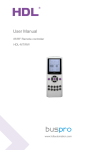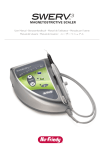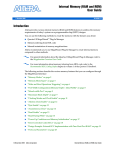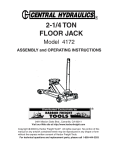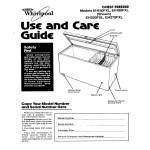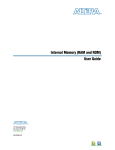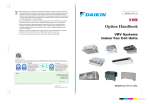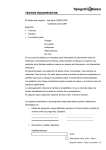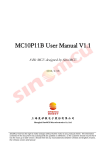Download MVS-31 System Monitor User`s Manual
Transcript
DIY Electronics
Southern Cross II
8031 Single Board Computer
MVS-31 System Monitor
User's Manual
Written by
MicroValley Systems
24 Ballandry Crescent
Greensborough 3088
Melbourne, Australia
(613) 9434-3806
Micro-Valley Systems
MVS-31 User's Manual
Contents
Introduction ............................................................................................................................. 2
MVS-31 Monitor/Debugger Features ...................................................................................... 2
Getting Started......................................................................................................................... 2
Monitor commands and conventions ....................................................................................... 2
Command Set Summary .......................................................................................................... 3
Monitor Commands - Description ........................................................................................... 4
DA - DisAssemble program....................................................................................... 4
DB - Display Breakpoints.......................................................................................... 4
DI - Display Internal data memory ............................................................................ 4
DX - Display eXternal data memory ......................................................................... 5
DR - Display Registers .............................................................................................. 5
DS - Display Special function registers ..................................................................... 5
DT - Display Time and date ...................................................................................... 5
DW - Display Watchpoints........................................................................................ 5
MI - Modify Internal data memory............................................................................ 6
MX - Modify eXternal data memory ......................................................................... 6
ST - Set Time and date .............................................................................................. 6
<space> - Single step................................................................................................. 6
N - Next in-line instruction single stepping ............................................................... 7
G - Go from breakpoint ............................................................................................. 7
J - Jump to user program ........................................................................................... 7
E - Enter breakpoint................................................................................................... 7
C - Clear breakpoint .................................................................................................. 7
W - enter Watchpoint ................................................................................................ 8
K - Kill watchpoint .................................................................................................... 8
V - View watchpoint data .......................................................................................... 8
S0 - Load a Motorola S19 format file........................................................................ 8
S1 - Load a Motorola S19 format file........................................................................ 8
: - Load an Intel HEX format file.............................................................................. 9
Register Modify commands....................................................................................... 9
User Accessible Input/Output Functions ................................................................................. 10
Input/Output Functions and Interrupts..................................................................................... 10
Summary of Input/Output Functions........................................................................................ 10
Monitor Functions - Description.............................................................................................. 11
What happens at RESET?........................................................................................................ 14
Downloading and Running programs ...................................................................................... 14
Breakpoints - Things you should know! .................................................................................. 15
Breakpoints, Single-Stepping and Interrupts ........................................................................... 16
Appendix A - Downloadable File Formats .............................................................................. 18
Appendix B - Error Messages.................................................................................................. 19
Appendix C - Input/Output Functions (Software Listings) ...................................................... 20
1
Micro-Valley Systems
MVS-31 User's Manual
Introduction
The MVS-31 system monitor is intended for use with the DIY Electronics "Southern Cross II", an 8031
based single board computer. This board may be used as a software development and debugging tool
connected to a host computer. 8051 assembly language programs would be edited and assembled on the host
system and then transferred to the SBC-31 board for execution and debugging.
MVS-31 Monitor/Debugger Features
•
•
•
•
•
•
•
•
•
Display of internal and external data memory in hex and ascii.
Modify internal and external data memory.
Display all internal 8031 registers, including the Special Function Registers (SFRs).
Modify all 8031 registers and SFRs individually.
Disassemble code memory.
Download files from a host PC in both Motorola S19 and Intel HEX formats.
Runs code in REAL TIME.
Program execution and debugging with jump to program, continue from breakpoint, single stepping, next
"in-line" single stepping. Set watchpoints to display flags and variables.
User accessible functions for various I/O routines such as input and output character, etc.
Getting Started
Refer to the "Getting Started - Running in 8031 Mode" section in the Southern Cross II Manual for details on
configuring the hardware. Turn on the power when ready. The monitor uses automatic baud rate detection to
configure the host port. Press Carriage Return ( Enter↵ ). The following sign-on banner should be displayed.
*******************************************************
*
DIY Electronics - Southern Cross II
*
*******************************************************
* MVS-31 System Monitor
Version x.x
dd-mon-yy *
* Copyright (c) 1995
MicroValley Systems, Australia *
*******************************************************
Type "?" at the prompt to display a list of available commands. Invalid commands will be ignored and "?"
displayed.
Monitor commands and conventions
MVS-31 is ready to accept keyboard commands whenever the ">" prompt is displayed. These commands
consist of one or two characters followed by any hexadecimal parameters as required. Commands and
parameters may be entered in upper or lower case.
Throughout this manual, the following conventions are used:
•
•
•
•
The command typed by the user appears first.
Parameters to be entered by the user are shown inside "<>" symbols (eg. <xxxx>). Entering a non-hex
character during entry of hex parameters will cause the command to abort and a "?" displayed.
Ascii characters are defined to be in the range $20-$7D
All hexadecimal parameters are preceeded by a "$" symbol.
2
Micro-Valley Systems
MVS-31 User's Manual
Command Set Summary
?
Display help screens
DA
DB
DI
DX
DR
DS
DT
DW
MI
MX
ST
DisAssemble code
Display Breakpoints
Display Internal memory in hex and ascii
Display eXternal memory in hex and ascii
Display Registers
Display Special function fegisters (SFRs)
Display Time and date
Display Watchpoints
Modify Internal memory
Modify eXternal memory
Set Time and date
<space>
N
G
J
E
C
W
K
V
S0, S1
:
Single step
Next "in-line" instruction single step
Go from current Program Counter value
Jump to user program
Enter breakpoint
Clear breakpoint
enter Watchpoint
Kill watchpoint
View watchpoint data
Load Motorola S19 format file
Load Intel HEX format file
A
B
DPH
DPL
DPTR
IE
IP
P0
P1
P2
P3
PCON
PSW
R0
R1
R2
R3
R4
R5
R6
R7
SBUF
SCON
SP
TCON
TMOD
TH0
TL0
TH1
TL1
Accumulator
B register
Data Pointer High byte
Data Pointer Low byte
Data Pointer (16-bits)
Interrupt Enable register
Interrupt Priority register
Port 0
Port 1
Port 2
Port 3
Power Control register
Program Status Word
Register 0
Register 1
Register 2
Register 3
Register 4
Register 5
Register 6
Register 7
Serial Port Buffer register
Serial Port Control register
Stack Pointer
Timer/Counter Control register
Timer/Counter Mode control register
Timer/Counter 0 High byte
Timer/Counter 0 Low byte
Timer/Counter 1 High byte
Timer/Counter 1 Low byte
3
Micro-Valley Systems
MVS-31 User's Manual
Monitor Commands - Description
DA - DisAssemble program
Syntax: DA <xxxx>
Disassemble the binary code in program memory beginning at address <xxxx>. The display format is
as follows.
1000: 020F2E
1003: EA MOV
etc
LJMP
A,R2
0F2E
Note that all numeric values are displayed in hexadecimal.
Instructions that contain a relative offset, such as JC, CJNE, DJNZ, AJMP, etc, have the actual
destination address printed instead of the offset. Therefore the instruction
1004: B47005
1007: xxxxxx
CJNE
A,#70,100C
has the offset value (05) added to the address of the next instruction (1007) to form the destination
address (100C).
One line of code is disassembled and printed and then output pauses. Press <CR> to exit the command
or any other key to disassemble the next opcode.
DB - Display Breakpoints
Syntax: DB
Display the address of all currently set breakpoints.
DI - Display Internal data memory
Syntax: DI <xx>
Display the contents of internal data memory starting at address <xx> in hex and ascii, 16 bytes per
line. Non ascii characters are displayed as a period (.)
This command displays the 16 bytes starting at address <xx> and pauses. Valid commands are:
<space> ................... next 16 bytes
<backspace> ............ previous 16 bytes
<CR> ....................... exit
Address range is from $00 to $7F and is automatically wrapped around as needed.
4
Micro-Valley Systems
MVS-31 User's Manual
DX - Display eXternal data memory
Syntax: DX <xxxx>
Display the contents of external data memory starting at address <xxxx> in hex and ascii, 16 bytes per
line. Non ascii characters are displayed as a period (.).
Valid commands as per the "DI" command.
The address range is from $0000 to $FFFF and is automaticall wrapped around as needed.
DR - Display Registers
Syntax: DR
Display the current contents of the 8031 registers. The Program Status Word is displayed as individual
bits. Two lines are printed as follows:
A B DPTR SP R0 R1 R2 R3 R4 R5 R6 R7 CAFrrOxP PC
Opcode Mnemonic
xx xx xxxx xx xx xx xx xx xx xx xx xx xxxxxxxx xxxx xxxxxx xxxxxxxxxx
The first line is a heading and the second line is the contents of the corresponding register above it. A
disassembled output of the opcode at the PC address is also displayed. The register bank displayed
(R0-7) is determined by bits "rr" in the Program Status Word.
DS - Display Special function registers
Syntax: DS
Display the current contents of the 8031 Special Function Registers (SFRs). Two lines are printed as
follows:
P0 P1 P2 P3 IE IP PCON SBUF SCON TCON TMOD TH0 TL0 TH1 TL1
xx xx xx xx xx xx xx
xx
xx
xx
xx
xx
xx xx xx
DT - Display Time and date
Syntax: DT
Displays the current date and time. The time is displayed in 24 hour mode.
eg. Mon, 28-Aug-95 15:12:30
DW - Display Watchpoints
Syntax: DW
Display the address of all currently set watchpoints
5
Micro-Valley Systems
MVS-31 User's Manual
MI - Modify Internal data memory
Syntax: MI <xx>
The contents of internal data memory at address <xx> are displayed in hex and new hex data may be
entered. Address can be in the range $00-7F. The following commands are valid:<space> ................... next location
<backspace> ............ previous location
<=> .......................... redisplay current location
<CR> ....................... exit
Entering any other non-hex character will be followed by a "?" and the command aborted.
A "read-after-write" test is NOT performed when entering data.
The "=" command is useful for continually reading the contents of an I/O port or hardware register.
MX - Modify eXternal data memory
Syntax: MX <xxxx>
The contents of external data memory at address <xxxx> are displayed in hex and new hex data may
be entered.
Refer to "MI" command for further details
ST - Set Time and date
Syntax: ST
Set the time and date on the clock/calendar chip. MVS-31 prints the following prompt and positions
the cursor under the first character to be entered.
eg.
MM/DD/YY DOW
08/28/95 1
HH:MM:SS
15:17:00
This sets the clock to Mon, August 8, 1995 3:17pm.
The characters "/" and ":" are automatically printed by the monitor and NOT entered by the user.
The clock runs in 24-hour mode. Therefore 1pm is entered as 13. No check is made for invalid values
eg. Month (MM) = 17. Unpredictable results may occur if invalid values are entered.
Note:
Day of Week (DOW)
Sun = 0, Mon = 1, Tue = 2, Wed = 3, Thu = 4, Fri = 5, Sat = 6
<space> - Single step
Syntax: <space>
Execute the next instruction, stop and display registers and any watchpoint data. Control is transferred
to the monitor. The program counter value shown is the address ot the NEXT instruction to be
executed. The opcode and mnemonic shown is that of the NEXT instruction to be executed.
Note: Calls by the user's program to the monitor's I/O routines are treated as a single instruction.
6
Micro-Valley Systems
MVS-31 User's Manual
N - Next in-line instruction single stepping
Syntax: N
Operation of this command is similar to "space" type single stepping with the exception that "LCALL"
and "ACALL" instructions cause the subroutine to be treated as a single instruction, ie executed
without single stepping. Program execution stops at the next "in-line" instruction following the
subroutine call.
G - Go from breakpoint
Syntax: G
Commence executing code from the current program counter address. Used mainly to continue
program execution after a breakpoint. The code runs in "real time" until another breakpoint is
encountered.
J - Jump to user program
Syntax: J <xxxx>
Jump to address <xxxx> and begin executing. A breakpoint at that address will cause the registers to
be displayed and control returned to the monitor. The code runs in "real time" until a breakpoint is
encountered.
E - Enter breakpoint
Syntax: E <xxxx>
Enter a breakpoint at address <xxxx>. A maximum of 8 breakpoints are allowed.
A number of checks are done when the breakpoint is first entered. These are:
Have the maximum number of breakpoints already been set?
Does a breakpoint already exist at that address?
Does a breakpoint already exist within 2 addresses either side of that address?.
The first two tests are self explanatory. The third test is to prevent one breakpoint from "overlapping"
another. Refer to the section on "Breakpoints - Things you should know!" for further explanation.
C - Clear breakpoint
Syntax: C <xxxx>
Clear (delete) the breakpoint at address <xxxx>. Entering "X" or "x" instead of an address deletes
ALL breakpoints currently set.
7
Micro-Valley Systems
MVS-31 User's Manual
W - enter Watchpoint
Syntax: W <xx>
Enter a watchpoint at address <xx>. Watchpoints can only be set in internal data memory (address
range $00-7F). A maximum of 8 watchpoints are allowed.
A number of checks are done when entering the watchpoint, such as:
Have the maximum number of watchpoints already been set?
Does a watchpoint already exist at that address?
K - Kill watchpoint
Syntax: K <xx>
Kill (delete) the watchpoint at address <xx>. Address can be in the range $00-7F. Entering "X" or "x"
instead of an address deletes ALL watchpoints currently set.
V - View watchpoint data
Syntax: V
View (display) the contents at the watchpoint addresses. The watchpoint address is printed followed by
a colon (:) followed by the data at that address.
S0 - Load a Motorola S19 format file
S1 - Load a Motorola S19 format file
Syntax: S1
Loads a Motorola S19 formatted file into memory. Data transfer is via the host serial port. This
command is normally terminated on receipt of an "S9" record. Clears any breakpoints already set.
There is no need to enter the "S1" command as this is part of the Motorola file format. Just send the
file and the monitor will automatically detect it. Each “start of block” character (“S”) is echoed back to
the screen.
Load errors cause the command to abort immediately. Load errors are caused by either a non hex
character received or by a checksum error. One of the following error messages is displayed whenever
a load error occurs.
" Error: Bad hex character received ... Press <ESC> to exit "
" Error: Bad checksum ... Press <ESC> to exit "
No "read-after-write" testing occurs as the file is loaded. It is up to the user to ensure that the file is
loaded into the correct memory locations.
8
Micro-Valley Systems
MVS-31 User's Manual
: - Load an Intel HEX format file
Syntax: :
Load an Intel HEX formatted file into memory. Data transfer is via the host serial port. This command
is normally terminated on receipt of an "EOF" record. Clears any breakpoints already set.
There is no need to enter the ":" command as this is part of the Intel file format. Just send the file and
the monitor will automatically detect it. Each “start of block” character (“:”) is echoed back to the
screen.
Refer to "S1" command for further details.
Register Modify commands
These commands allow the user to modify any of the internal Special Function Registers (SFRs)
simply by entering its name The monitor will respond with the address of the register and its current
contents. Enter any new hex data as required or press <Enter> to exit.
Example:
>P0
80: xx
(xx = current contents in hex)
Entering "DPTR" will display both "DPL and DPH" together and allow both to be modified by
entering a single 16-bit value ("DPH" value first).
Note that the "R0-R7" registers accessed will depend on the current register bank selected in the
"PSW" register.
9
Micro-Valley Systems
MVS-31 User's Manual
User Accessible Input/Output Functions
The MVS-31 monitor provides a large number of I/O functions which can be called from user programs.
These functions are accessed by executing an "LCALL <xxxx>" instruction from the user's program, where
<xxxx> is the address of the routine required. The I/O function equates are supplied on disk in a file called
"MVS31.EQU". Include this file at the start of your program to access these functions.
A number of 8031 registers are used to pass arguments between the I/O functions and the user program.
Generally, 8-bit arguments are passed via the "A" accumulator and 16-bit arguments via the the "DPTR"
register. Unless otherwise specified, all other registers are preserved. Refer to the specific function for
further details.
Some I/O routines require a number of bytes of user stack space. Refer to the software listings in Appendix C
for further details.
All the "input hex" and "input decimal" calls exit with C = 0 if valid data is entered. If a non hex or decimal
character is entered, then the routine exits with C = 1 and the character is returned in the A accumulator. All
the input/output functions use the host serial port.
NOTE: Use a "LJMP NXTCMD" instruction to terminate the user's program. This method allows control to
be passed back to the monitor when the program has finished
Input/Output Functions and Interrupts
All of these I/O functions use one or more 8031 registers, not only to pass arguments back and forth but also
within the functions themselves. For example, inputting characters using "INCH" requires that, during
execution of the function, the "DPTR" register hold the address of the host port, even though it is left
unchanged once the function exits. If the "INCH" routine is interrupted whilst waiting for input and the
"DPTR" register is altered before returning to the function then it will no longer be pointing to the host port.
Any character returned will be garbage. Therefore, user interrupt routines should leave the "A" and "DPTR"
registers unchanged. If they are to be used in the interrupt routine, push them on to the stack first and pop
them off before exiting.
Summary of Input/Output Functions
NXTCMD
ANYIN
INCH
INCHE
INHEX
IN2HEX
IN4HEX
INDEC
BCD
OUTCH
OUTHEX
OUT2H
OUT2HS
OUT4H
OUT4HS
OUTS
PDATA
PSTRING
PCRLF
RDTIME
WRTIME
$1FC0
$1FC3
$1FC6
$1FC9
$1FCC
$1FCF
$1FD2
$1FD5
$1FD8
$1FDB
$1FDE
$1FE1
$1FE4
$1FE7
$1FEA
$1FED
$1FF0
$1FF3
$1FF6
$1FF9
$1FFC
Transfer control to MVS-31 monitor
Check for character input
Input character without input
Input character with echo
Input a hex digit
Input 2 hex digits
Input 4 hex digits
Input a decimal digit
Input 2 decimal digits
Output character
Output hex digit
Output 2 hex digits
Output 2 hex digits followed by space
Output 4 hex digits
Output 4 hex digits followed by space
Output space
Output ascii string
Output ascii string preceeded by CR, LF
Output Carriage Return/Line Feed
Read the time and date from the clock/calendar
Write new time and date to clock/calendar
Monitor Functions - Description
10
Micro-Valley Systems
NXTCMD
MVS-31 User's Manual
$1FC0 Transfer control to the MVS-31 monitor
Program control is transferred to the monitor.
ANYIN
$1FC3 Check for character input
C = 1 if a character received; C = 0 if no character received.
INCH
$1FC6 Input character without echo
The 8-bit character is returned in the A accumulator.
INCHE
$1FC9 Input character with echo
The character is returned in the A accumulator with the most significant bit (bit 7) clear.
The character is also echoed to the terminal.
INHEX
$1FCC Input a hex digit
The hex digit is returned in the right nibble of the A accumulator.
IN2HEX
$1FCF Input 2 hex digits
The hex digits are returned in the A accumulator.
IN4HEX
$1FD2 Input 4 hex digits
The 4 hex digits are returned in the DPTR register. Any non-hex character will be returned
in the A accumulator. If valid hex data is entered then the A accumulator is preserved.
INDEC
$1FD5 Input a decimal digit
The decimal digit is returned in the right nibble of the A accumulator.
BCD
$1FD8 Input 2 decimal (BCD) digits
The decimal digits are returned in the A accumulator
OUTCH
$1FDB Output character
Output the character in the A accumulator to the terminal.
11
Micro-Valley Systems
OUTHEX
MVS-31 User's Manual
$1FDE Output hex digit
The digit is contained in the right nibble of the A accumulator. The A accumulator is
destroyed.
OUT2H
$1FE1 Output 2 hex digits
Output the 2 hex digits (byte) in the A accumulator. The A accumulator is destroyed.
OUT2HS
$1FE4 Output 2 hex digits followed by space
As per "OUT2H" but with a trailing space. The A accumulator is destroyed.
OUT4H
$1FE7 Output 4 hex digits
Output the 4 hex digits (2 bytes) in the DPTR register. The A accumulator is destroyed.
OUT4HS
$1FEA Output 4 hex digits followed by space
As per "OUT4H" but with a trailing space. The A accumulator is destroyed.
OUTS
$1FED Output space
Output a space. The A accumulator is destroyed.
PDATA
$1FF0
Output ascii string
Output the ascii string pointed to by the DPTR register. The string must be terminated by a
NULL character ($00). On exit, the DPTR register is left pointing to the NULL character.
The A accumulator is destroyed.
PSTRNG
$1FF3
Output string preceeded by CR,LF
As per "PDATA" except that carriage return/line feed preceeds the ascii string. The A
accumulator is destroyed.
PCRLF $1FF6
Output Carriage Return/Line Feed
Output carriage return and line feed characters to the terminal. The A accumulator is
destroyed.
12
Micro-Valley Systems
RDTIME
$1FF9
MVS-31 User's Manual
Read the time and date from the clock/calendar
Returns 8 bytes of clock data into a memory buffer pointed to by the R0 register. Internal
memory must be used for this function.
The data is in Binary Coded Decimal ( BCD ) format and is organised as follows:
Month, Date, Year, Day of Week, Hours, Minutes, Seconds, 1/100ths of seconds
The "Hours" byte is returned in 24-hour format ( 1pm = 13 hours).
The R0 register is unaffected. Register “A” is destroyed.
WRTIME
$1FFC Write new time and date to clock/calendar
On entry, register R0 points to an 8 byte memory buffer containing the new time and date
information to be written into the clock/calendar chip. Internal memory must be used for
this function.
The data should be in BCD format and organised as per the "RDTIME" function. The
"hours" byte should be in 24-hour format. No check is made for valid data.
The R0 register is unaffected. Register “A” is destroyed.
13
Micro-Valley Systems
MVS-31 User's Manual
What happens at RESET?
The monitor can detect the difference between a "power on reset" (POR) and pressing the RESET button. The
POR sequence is as follows:
1.
2.
3.
4.
5.
6.
7.
Set the monitor stack pointer ( The monitor uses its own separate stack area ).
Initialize the hosr serial port (automatic baud rate detection).
Print the signon banner.
Clear all breakpoint entries.
Initialize the user's interrupt vectors ( at $4000 ).
Initialize user's registers.
Print ">" prompt and wait for command.
Pressing the RESET button bypasses steps 4 and 5 above. This allows users to regain control by pressing
"RESET" without losing any breakpoint information or changing any interrupt vectors already set by the user
program.
Downloading and Running programs
Programs must first be assembled and then downloaded to the SBC-31 computer. The "host" port is used for
downloading programs. The monitor will accept files in Motorola S19 or Intel HEX format. A description of
these formats appears in Appendix A.
The SBC-31 has 16K of user program RAM starting at address $4000. User programs should be ORG'd to
start at this address, including the interrupt vectors. Except for reset and timer 2, all the interrupt vectors have
been mapped into this area as follows:
Interrupt
Source
External Interrupt 0
Timer 0 Interrupt
External Interrupt 1
Timer 1 Interrupt
Serial port interrupts
8031 Interrupt
Vectors
$0003
$000B
$0013
$001B
$0023
User Interrupt
Vectors
$4003
$400B
$4013
$401B
$4023
User Interrupt Vectors
The monitor contains an "LJMP" instruction at the 8031 interrupt vector address that transfers control to the
user's interrupt vector. Therefore, user interrupt routines are delayed two instruction cycles by the "LJMP"
instruction.
At power up, the user's interrupt vectors are initialized to jump to interrupt "trap" routines in the monitor. The
trap routine prints a message identifying the interrupt source and the monitor then waits for a command.
User program RAM is mapped in both code and data space. Any instruction that accesses external data
memory is also able to access the user program RAM.
NOTE:
The monitor uses four bytes of user program RAM, beginning at address $7FFC. Three
bytes are used to assemble a program patch for accessing internal data RAM. The fourth
byte is used to access an optional clock/calendar chip. User code must NOT reside in this
area as it will be overwritten.
14
Micro-Valley Systems
MVS-31 User's Manual
Breakpoints - Things you should know!
A short description of how breakpoints are implemented by the monitor is necessary in order that the user is
aware of certain "anomalies" that can occur.
Breakpoints are not affected by pressing RESET but are automatically cleared after downloading a
file.
Entering a breakpoint consists of replacing three bytes of the user's code, beginning at address <xxxx>, with
an "LCALL" instruction into the monitor. The bytes are not replaced when the breakpoint is entered but
rather when control is transferred to the user program via a "J, G, or N" command.
The user's code is intact in memory whenever the monitor program is in control.
Do not change any data at an address where a breakpoint is set (or the next two locations). The new data will
be replaced with the original data when control is transferred back to the user's program.
A check is done when breakpoints are entered to test for "overlapping" breakpoints. The monitor will not
allow a breakpoint to be entered if it is within two address locations either side of an existing breakpoint. This
prevents one breakpoint from overwriting or "overlapping" another when they are inserted back into the user's
program prior to running it.
The user's program is started with the "J" command. The program will run in real time until a breakpoint is
encountered, at which point control is transferred to the monitor. The monitor restores the user's original
code, displays the program registers (and any watchpoint data) and waits for a command. The program
counter address shown is that of the NEXT instruction to be executed.
Press "G" to continue executing.
Wait on! What about the breakpoints?
When the breakpoint was encountered, the monitor restored the user's original code bytes ie. all the
breakpoints were removed from the user's program. Before continuing to execute the user program, the
monitor must put all the breakpoints back. However it cannot do this until AFTER it has executed the next
instruction. If breakpoints were restored immediately, the next instruction would never be executed, as it
would be a breakpoint. To overcome this problem, the monitor automatically executes a single step first. The
monitor regains control after the single step, restores all breakpoints and then transfers control back to the
user's program.
The user's code always runs in real time between breakpoints except for that first instruction.
Unfortunately, there is an exception to this rule!
Remember that a breakpoint replaces three bytes of user code.
This means that if a breakpoint is set at a one or two byte instruction, the following instruction(s) will also be
affected. After executing the initial single step the monitor checks whether the next instruction to be executed
is within two address locations of a breakpoint. If so, the monitor cannot replace breakpoints and continue as
this would corrupt the next instruction. Therefore the monitor executes another single step. The process is
repeated until the return address is at least three bytes away from the breakpoint address.
This does not normally present a problem as the user's program will be running in real time again within one
or two instructions of a breakpoint. However, this will depend on the next instruction to be executed. An
example will help to explain.
15
Micro-Valley Systems
MVS-31 User's Manual
Consider the following program segment.
LOOP
...
MOV
CJNE
...
R6,#10
R6,#0,LOOP
;SET TIME DELAY REQUIRED
;WAIT UNTIL INTERRUPT COUNTER = 0
Example 1
Register "R6" is decremented within a timer interrupt routine. The software waits for "R6" to reach zero
before continuing. A simple time delay using continuous timer interrupts!
Assume that a breakpoint is set at the "MOV" instruction (a two byte instruction). The program runs to the
breakpoint, restores the user's code and stops. The user presses "G" to continue. The monitor executes a
single step. The next instruction, "CJNE", is within two bytes of the breakpoint at the "MOV" instruction so
the monitor executes another single step. However the program will not step past "LOOP" until register "R6"
reaches zero. Therefore the monitor will continuously single-step the "CJNE" instruction. The program is not
running in real time! The user's program will only run in real time once it has passed the "CJNE" instruction.
Setting breakpoints at one and two byte instructions can also have other consequences. Once again, an
example will help.
AAAA
BBBB
...
JC
...
...
CLR
CLR
MOV
...
BBBB
;JUMP IF CARRY CLEAR
A
C
P0,#55
Example 2
The two instructions before label "BBBB" are both single byte instructions. Setting a breakpoint at either of
these instructions will also affect the "MOV" instruction. During execution it is possible that the program will
bypass the breakpoint and jump directly to label "BBBB" (as at "AAAA"). However the "MOV" instruction
has been altered by the breakpoint and the program could crash.
Most programmers collect subroutines and position them at the end of their code (I certainly do!). Setting a
breakpoint within two bytes of the end of a subroutine would also affect the start of the following subroutine.
That subroutine will not run correctly when called and could crash as well.
As a general rule, do not set breakpoints within two bytes prior to the destination of a "jump"
instruction or the start of a subroutine.
Breakpoints, Single-Stepping and Interrupts
The single-stepping function in the monitor uses "Timer 2" of the 8032/52 processor. The timer is set to
generate an interrupt during execution of the next instruction. The instruction will be completed and the
interrupt will then transfer control back to the monitor. Some instructions, such as "RETI" and those
accessing the "IE" and "IP" registers, block this interrupt until at least one more instruction has been
executed. This could result in several instructions being executed before the monitor regains control.
The monitor disables all interrupts (clears the "EA" bit) whilst it is running. Therefore any interrupts
occurring while the monitor is waiting for a command will be ignored. The monitor enables all interrupts (sets
the "EA" bit) before tranferring control back to the user's program via the "J, G, N or <space>" commands. If
the user's program needs to stop interrupts it should do so on an individual basis and not by using the global
"EA" bit.
16
Micro-Valley Systems
MVS-31 User's Manual
In order for single-stepping to function correctly, the monitor initializes the interrupt priority of timer 2 to be
higher than all the other interrupts (the "PT2" bit in the "IP" register is set and all others are cleared). Timer 2
interrupts are enabled by setting the "ET2" bit in the "IE" register. The "PT2" and "ET2" bits are always set
by the monitor when single-stepping. Setting another interrupt source to the same priority level as timer 2
could affect the proper operation of the single-step function.
Example 3:
We want to single step through a timer interrupt routine. The timer interrupts are occurring at regular
intervals, say 100uS. We set a breakpoint inside the interrupt routine and then start the program. The
interrupt occurs and the program stops at the breakpoint. The monitor is waiting for a command.
Meanwhile the user's timer is generating many more interrupts but they are ignored. When control is
passed back to the user's program with a <space> command there will be two interrupts pending, one
from timer 2 and one from the user's interrupt timer. If the interrupt timer has the same priority level as
timer 2 it will get precedence and the single step will be ignored. The user's interrupt routine will
interrupt itself and the user's stack will grow.
Wherever possible the interrupt priorities should be left unchanged. In this case all interrupts will be
ignored when single-stepping.
As mentioned in the previous example, single-stepping through an interrupt routine is possible by first setting
a breakpoint within the routine and then running the program. When the interrupt occurs, the program will hit
the breakpoint and stop. All monitor commands are now available, including single-stepping. Single-stepping
through an interrupt routine will ignore any further interrupts. However, pressing "G" will allow further
interrupts to be processed. Should another interrupt be pending when "G" is pressed then it is possible that the
interrupt routine will itself be interrupted before it can finish, causing the stack to overflow eventually. Of
course the program will stop at the breakpoint again.
Interrupts will be processed when the user's program is running between breakpoints.
This is also true even if pressing "G" causes the program to continuously single step, as in example 1. Even
though the program is not running in real time, interrupts will still be processed in between single steps.
17
Micro-Valley Systems
MVS-31 User's Manual
Appendix A - Downloadable File Formats
Motorola S19 format
The Motorola S19 format breaks up a file into separate blocks or records. Each record is further divided into
fields containing information about that record.
All fields contain ASCII characters to represent hexadecimal values. For example, the single hex byte "$5A"
is represented as two characters, ascii "5" and ascii "A".
The following table defines each field within a record.
Field
Record Type
Byte Count
Load Address
Data
Checksum
Description
Two ASCII characters identifying the start and type of record.
ASCII S1 - Data Record
ASCII S9 - EOF Record
Two ASCII characters representing the number of bytes to follow,
including the Address, Data and Checksum fields. An EOF record has a
byte count of three.
Four ASCII characters representing the address at which to start loading
this record ( high byte first ). This field contains four ASCII zeros in an
EOF record.
Two ASCII characters representing each byte of data. There are no data
bytes in an EOF record.
Two ASCII characters representing the 1's complement of the sum of the
byte count, load address and data fields.
Intel HEX format
The Intel HEX format is similar to the Motorola S19 format in that the file is also broken up into records and
fields. All hexadecimal values are represented as ASCII characters.
The following table defines each field within a record.
Field
Record Mark
Byte Count
Load Address
Record Type
Data
Checksum
Description
An ASCII colon (:) indicates the start of a record.
Two ASCII characters representing the number of data bytes in this record.
An EOF record has two ASCII zeros in this field.
Four ASCII characters representing the address at which to start loading
this record ( high byte first ). This field contains four ASCII zeros in an
EOF record.
Two ASCII characters identifying the type of record.
00 = Data Records
01 = EOF Record
Two ASCII characters representing each byte of data. There are no data
bytes in an EOF record.
Two ASCII characters representing the 2's complement of the sum of the
byte count, load address, record type and data fields.
18
Micro-Valley Systems
MVS-31 User's Manual
Appendix B - Error Messages
Error: No breakpoint at this address
The breakpoint routine in the monitor has been called but a breakpoint does not exist at that address. The
user's program is probably corrupt and should be downloaded again.
Error: Bad hex character received ... Press <ESC> to exit
An invalid hex character was received while downloading a file. Valid hex characters are "0-9, A-F" (upper
or lower case). Abort the file transmission before pressing the <ESC> key. Check that the file is not corrupted
and download again if all OK.
Error: Bad checksum ... Press <ESC> to exit
When downloading files, the monitor calculates a running checksum as each record is received. This
checksum is compared to the checksum received at the end of the record. If they are not the same, this error
message is printed. Abort the file transmission before pressing the <ESC> key. Check that the file is not
corrupted and download again if all OK.
Error: Breakpoint table full
The maximum number of breakpoints have already been entered. Delete one or more breakpoints so that new
breakpoints can be entered.
Error: Breakpoint already exists
A breakpoint has already been set at that address.
Error: Overlapping breakpoint
The user attempted to enter a breakpoint within two address locations of an existing breakpoint.
Error: No breakpoint there
The user tried to clear (delete) a breakpoint that does not exist
Error: Watchpoint table full
The maximum number of watchpoints have already been entered. Delete one or more watchpoints so that new
watchpoints can be entered.
Error: Watchpoint already exists
A watchpoint has already been set at that address.
Error: No watchpoint there
The user tried to clear (delete) a watchpoint that does not exist
19
Micro-Valley Systems
MVS-31 User's Manual
Appendix C - Input/Output Functions (Software Listings)
SPI
EQU
$F000
;SERIAL PERIPHERAL INTERFACE (SCC2691)
**********************************
* SPI (SCC2691) REGISTER EQUATES
**********************************
;
MR1
EQU
SPI+0
MR2
EQU
SPI+0
SR
EQU
SPI+1
CSR
EQU
SPI+1
CMR
EQU
SPI+2
RHR
EQU
SPI+3
THR
EQU
SPI+3
ACR
EQU
SPI+4
ISR
EQU
SPI+5
IMR
EQU
SPI+5
CTU
EQU
SPI+6
CTUR
EQU
SPI+6
CTL
EQU
SPI+7
CTLR
EQU
SPI+7
;MODE REGISTER 1
;MODE REGISTER 2
;STATUS REGISTER
;CLOCK SELECT REGISTER
;COMMAND REGISTER
;RECEIVE HOLDING REGISTER
;TRANSMIT HOLDING REGISTER
;AUXILIARY CONTROL REGISTER
;INTERRUPT STATUS REGISTER
;INTERRUPT MASK REGISTER
;COUNTER/TIMER UPPER
;COUNTER/TIMER UPPER REGISTER
;COUNTER/TIMER LOWER
;COUNTER/TIMER LOWER REGISTER
***********************************
* PRINT ASCII STRING TO HOST PORT
* PRECEEDED BY CR/LF
***********************************
;
; "DPTR" POINTS TO START OF STRING.
; STRING MUST BE TERMINATED BY "0".
;
; EXIT CONDITIONS AS PER "PDATA"
;
PSTRING
LCALL PCRLF
;OUTPUT CR/LF FIRST
*************************************
* OUTPUT ASCII STRING TO HOST PORT
*************************************
;
; "DPTR" POINTS TO START OF STRING.
; STRING MUST BE TERMINATED BY "0".
;
; ON EXIT:
"A" DESTROYED
;
:
"DPTR" POINTS TO STRING TERMINATOR ("0")
;
PDATA
CLR
A
;OFFSET=0
MOVC A,@A+DPTR
;GET CHARACTER
JZ
PDATAX
;EXIT IF TERMINATOR ("0")
LCALL OUTCH
;ELSE PRINT CHARACTER
INC
DPTR
;POINT TO NEXT CHARACTER
SJMP PDATA
;CONTINUE WITH REST OF STRING
PDATAX
RET
;END OF STRING - FINISHED
20
(READ)
(WRITE)
(WRITE)
(READ)
(WRITE)
(WRITE)
(READ)
(WRITE)
(READ)
(WRITE)
(READ)
(WRITE)
Micro-Valley Systems
******************************
* OUTPUT CR/LF TO HOST PORT
******************************
;
; ON EXIT:
"A" DESTROYED
;
PCRLF
MOV A,#CR
LCALL OUTCH
MOV A,#LF
MVS-31 User's Manual
;SEND CARRIAGE RETURN
;FOLLOWED BY LINE FEED
******************************************
* OUTPUT CHARACTER IN "A" TO HOST PORT
******************************************
;
; NO REGISTERS AFFECTED
;
OUTCH
PUSH DPH
;SAVE "DPTR"
PUSH DPL
PUSH ACC
;SAVE CHARACTER
MOV DPTR,#SR
;POINT TO UART STATUS REGISTER
OUTCH1
MOVX A,@DPTR
;GET UART STATUS
JNB
A.2,OUTCH1
;WAIT FOR TRANSMITTER READY
MOV DPTR,#THR
;POINT TO TRANSMIT REGISTER
POP
ACC
;RETRIEVE CHARACTER
MOVX @DPTR,A
;SEND CHARACTER
POP
DPL
;RESTORE "DPTR"
POP
DPH
RET
********************************
* OUTPUT 4 HEX DIGITS IN "DPTR"
* FOLLOWED BY A SPACE
********************************
;
; EXIT CONDITIONS AS PER "OUT4H"
;
OUT4HS
LCALL OUT4H
SJMP OUTS
*****************************
* OUTPUT 2 HEX DIGITS IN "A"
* FOLLOWED BY A SPACE
*****************************
;
; EXIT CONDITIONS AS PER "OUT2H"
;
OUT2HS
LCALL OUT2H
;OUTPUT THE 4 DIGITS
;OUTPUT BYTE
******************
* OUTPUT A SPACE
******************
;
; ON EXIT: "A" DESTROYED
;
OUTS
MOV A,#$20
SJMP OUTCH
********************************
21
Micro-Valley Systems
* OUTPUT 4 HEX DIGITS IN "DPTR"
********************************
;
; ON EXIT:
"A" DESTROYED
;
"DPTR" PRESERVED
;
OUT4H
MOV A,DPH
LCALL OUT2H
MOV A,DPL
*****************************
* OUTPUT 2 HEX DIGITS IN "A"
*****************************
;
; ON EXIT:
"A" DESTROYED
;
OUT2H
PUSH ACC
SWAP A
LCALL OUTHEX
POP
ACC
******************************
* OUTPUT RIGHT NIBBLE IN "A"
******************************
;
; ON EXIT:
"A" DESTROYED
;
OUTHEX
ANL
A,#$0F
ADD A,#$30
CJNE A,#$3A,OUTHEX1
OUTHEX1
JC
OUTHEX2
ADD A,#$07
OUTHEX2
SJMP OUTCH
***************************************
* CHECK IF ANY INPUT FROM HOST PORT
***************************************
;
; ON EXIT:
C=0 IF NONE
;
C=1 IF SO
;
ANYIN
PUSH DPH
PUSH DPL
PUSH ACC
MOV DPTR,#SR
MOVX A,@DPTR
CLR
C
JNB
A.0,ANYIN1
SETB C
ANYIN1
POP
ACC
POP
DPL
POP
DPH
RET
MVS-31 User's Manual
;GET FIRST BYTE
;PRINT IT
;GET SECOND BYTE
;SAVE BYTE
;READY TO OUTPUT FIRST DIGIT
;RETRIEVE BYTE
;STRIP OFF LEFT NIBBLE
;CONVERT TO ASCII
;WAS DIGIT "0-9" ?
;JUMP IF SO
;ELSE MUST BE LETTER "A-F"
;OUTPUT DIGIT
;SAVE "DPTR"
;SAVE "A"
;POINT TO UART STATUS REGISTER
;GET UART STATUS
;ASSUME NO INPUT
;JUMP IF NO INPUT
;ELSE SET CARRY FLAG (INPUT!)
22
Micro-Valley Systems
MVS-31 User's Manual
****************************************************
* INPUT 8-BIT CHARACTER FROM HOST PORT INTO "A"
****************************************************
;
INCH
PUSH DPH
;SAVE "DPTR"
PUSH DPL
MOV DPTR,#SR
;POINT TO UART STATUS REGISTER
INCH1
MOVX A,@DPTR
;GET UART STATUS
JNB
A.0,INCH1
;WAIT FOR INPUT
MOV DPTR,#RHR
;POINT TO RECEIVE REGISTER
MOVX A,@DPTR
;GET CHARACTER
POP
DPL
POP
DPH
RET
**********************************************
* INPUT 7-BIT CHARACTER WITH ECHO INTO "A"
**********************************************
;
INCHE
LCALL INCH
;GET 8-BIT CHARACTER
ANL
A,#$7F
;STRIP OF HIGH BIT
LJMP OUTCH
;AND OUTPUT IT!
******************************************
* GET HEX ADDRESS (4 DIGITS) INTO "DPTR"
******************************************
;
; EXIT CONDITIONS AS PER "INHEX"
;
IN4HEX
LCALL IN2HEX
JC
IN4HEXX
MOV DPH,A
LCALL IN2HEX
JC
IN4HEXX
MOV DPL,A
CLR
C
IN4HEXX
RET
************************************
* GET HEX BYTE (2 DIGITS) INTO "A"
************************************
;
; EXIT CONDITIONS AS PER "INHEX"
;
IN2HEX
PUSH B
LCALL INHEX
JC
IN2HEXX
SWAP A
MOV B,A
LCALL INHEX
JC
IN2HEXX
ADD A,B
CLR
C
IN2HEXX
POP
B
RET
;GET FIRST BYTE (2 DIGITS)
;EXIT IF ERROR
;SAVE IT
;GET SECOND BYTE
;SAVE IT
;SAVE "B" REGISTER
;GET FIRST HEX DIGIT
;EXIT IF NOT HEX
;PUT DIGIT INTO HIGH NIBBLE
;SAVE IT
;GET SECOND DIGIT
;EXIT IF NOT HEX
;ADD IN FIRST DIGIT
;RESTORE "B" REGISTER
23
Micro-Valley Systems
MVS-31 User's Manual
*****************************************
* GET HEX CHARACTER (1 DIGIT) INTO "A"
*****************************************
;
; ON EXIT:
C=1 IF CHARACTER IS NOT HEX DIGIT (0-9, A-F)
;
C=0 OTHERWISE
;
INHEX
LCALL INCHE
;GET ASCII CHARACTER
CJNE A,#$30,INHEX1
;IS IT < "0" ?
INHEX1
JC
NOTHEX
;JUMP IF SO - ERROR!
CJNE A,#$3A,INHEX2
;IS IT > "9" ?
INHEX2
JNC
INHEX3
;JUMP IF SO
CLR
C
SUBB A,#$30
;CONVERT ASCII TO HEX
RET
INHEX3
INHEX4
INHEX5
ANL
CJNE
JC
CJNE
JNC
CLR
SUBB
RET
A,#$DF
A,#$41,INHEX4
NOTHEX
A,#$47,INHEX5
NOTHEX
C
A,#$37
; HERE IF INVALID HEX OR DECIMAL DIGIT
;
NOTHEX
EQU
*
NOTDEC
SETB C
RET
;CONVERT TO UPPER CASE
;IS CHARACTER < "A" ?
;JUMP IF SO - ERROR!
;IS IT > "F" ?
;JUMP IF SO - ERROR!
;CONVERT ASCII TO HEX
;SET CARRY BIT - ERROR
**********************************************
* GET DECIMAL CHARACTER (1 DIGIT) INTO "A"
**********************************************
;
; ON EXIT:
C=1 IF CHARACTER IS NOT DECIMAL DIGIT (0-9)
;
C=0 OTHERWISE
;
INDEC
LCALL INCHE
;GET ASCII CHARACTER
CJNE A,#$30,INDEC1
;IS IT < "0" ?
INDEC1 JC
NOTDEC
;JUMP IF SO - ERROR!
CJNE A,#$3A,INDEC2
;IS IT > "9" ?
INDEC2 JNC
NOTDEC
;JUMP IF SO
CLR
C
SUBB A,#$30
;CONVERT ASCII TO DECIMAL
RET
*********************************************
* GET BCD BYTE (2 DECIMAL DIGITS) INTO "A"
*********************************************
;
; EXIT CONDITIONS AS PER "INDEC"
;
BCD
PUSH B
;SAVE "B" REGISTER
LCALL INDEC
;GET FIRST DECIMAL DIGIT
JC
BCDX
;EXIT IF ERROR
SWAP A
;MOVE TO HIGH NIBBLE
MOV B,A
;SAVE INTO "B"
LCALL INDEC
;GET SECOND DECIMAL DIGIT
24
Micro-Valley Systems
BCDX
JC
ADD
CLR
POP
RET
MVS-31 User's Manual
BCDX
A,B
C
B
;COMBINE WITH FIRST DIGIT
;RESTORE "B" REGISTER
****************************************
* WRITE TIME TO CLOCK/CALENDAR CHIP
****************************************
;
; ON ENTRY: "R0" = ADDRESS OF 8 BYTE BLOCK CONTAINING NEW TIME DATA.
;
DATA BLOCK MUST BE IN "INTERNAL" RAM AREA.
;
DATA FORMAT = YY, MM, DD, DOW, HRS, MINS, SECS, SECS/100
; ON EXIT:
"A" DESTROYED
;
NO OTHER REGISTERS AFFECTED
;
WRTIME
MOV A,R0
;MOVE POINTER TO END OF DATA AREA
ADD A,#7
MOV R0,A
WRTIME1
LCALL RTC_OPEN
;ACCESS CLOCK CHIP
MOV A,@R0
;GET "SECS/100"
LCALL WRCLOCK
;WRITE IT
DEC
R0
MOV A,@R0
;GET "SECONDS"
LCALL WRCLOCK
DEC
R0
MOV A,@R0
;GET "MINUTES"
LCALL WRCLOCK
DEC
R0
MOV A,@R0
;GET "HOURS"
ANL
A,#%01111111
;SET FOR 24-HOUR MODE
LCALL WRCLOCK
DEC
R0
MOV A,@R0
;GET "DAY-OF-WEEK"
ORL
A,#%00010000
;IGNORE "RESET" PIN
ANL
A,#%11011111
;TURN ON "OSCILLATOR"
LCALL WRCLOCK
DEC
R0
MOV A,@R0
;GET "DATE"
LCALL WRCLOCK
DEC
R0
MOV A,@R0
;GET "MONTH"
LCALL WRCLOCK
DEC
R0
MOV A,@R0
;GET "YEAR"
LCALL WRCLOCK
CLR
C
RET
25
Micro-Valley Systems
MVS-31 User's Manual
******************************************
* READ TIME FROM CLOCK/CALENDAR CHIP
******************************************
;
; ON ENTRY: "R0" = ADDRESS OF 8 BYTE BLOCK WHERE CLOCK DATA WILL BE
;
RETURNED.
;
DATA BLOCK MUST BE IN "INTERNAL" RAM AREA.
;
DATA FORMAT = YY, MM, DD, DOW, HRS, MINS, SECS, SECS/100
; ON EXIT:
"A" DESTROYED
;
NO OTHER REGISTERS AFFECTED
;
RDTIME
MOV A,R0
;MOVE POINTER TO END OF DATA AREA
ADD A,#7
MOV R0,A
LCALL RTC_OPEN
;ACCESS CLOCK CHIP
LCALL RDCLOCK
;GET "SECS/100"
MOV @R0,A
;SAVE IT
DEC
R0
LCALL RDCLOCK
;GET "SECS"
MOV @R0,A
;SAVE IT
DEC
R0
LCALL RDCLOCK
;GET "MINS"
MOV @R0,A
;SAVE IT
DEC
R0
LCALL RDCLOCK
;GET "HRS'
ANL
A,#%01111111
;ALWAYS 24-HOUR MODE
MOV @R0,A
;SAVE IT
DEC
R0
LCALL RDCLOCK
;GET "DOW"
ANL
A,#$07
;MASK OFF ALL BUT "DOW" BITS
MOV @R0,A
;SAVE IT
DEC
R0
LCALL RDCLOCK
;GET "DATE"
MOV @R0,A
;SAVE IT
DEC
R0
LCALL RDCLOCK
;GET "MONTH"
MOV @R0,A
;SAVE IT
DEC
R0
LCALL RDCLOCK
;GET "YEAR"
MOV @R0,A ;SAVE IT
RET
**********************************************
* OPEN ACCESS TO THE CLOCK/CALENDAR CHIP
**********************************************
;
; FIRST EXECUTE 72 READS TO ENSURE THAT THE RTC IS CLOSED,
; THEN WRITE THE 64-BIT RECOGNITION PATTERN.
;
; THE HEX RECOGNITION PATTERN IS C5,3A,A3,5C,C5,3A,A3,5C (LSB TO MSB)
;
; ON EXIT, "A" DESTROYED
;
RTC_OPEN
PUSH DPH
PUSH DPL
PUSH B
MOV DPTR,#RTCADDR
;POINT TO CLOCK/CALENDAR CHIP
MOV B,#72
;SET UP FOR 72 READS
RTC_OP1
MOVX A,@DPTR
;READ DATA BIT
26
Micro-Valley Systems
RTC_OP2
DJNZ
MOV
MOV
LCALL
MOV
LCALL
MOV
LCALL
MOV
LCALL
DJNZ
POP
POP
POP
RET
MVS-31 User's Manual
B,RTC_OP1
B,#2
A,#$C5
WRCLOCK
A,#$3A
WRCLOCK
A,#$A3
WRCLOCK
A,#$5C
WRCLOCK
B,RTC_OP2
B
DPL
DPH
;LOOP UNTIL DONE
;SET UP TO SEND 2 BLOCKS OF "C5,3A,A3,5C"
;SEND "C5"
;SEND "3A"
;SEND "A3"
;SEND "5C"
;LOOP UNTIL BOTH BLOCKS SENT
***********************************************
* WRITE A BYTE TO THE CLOCK/CALENDAR CHIP
***********************************************
;
; ON ENTRY: "A" = BYTE TO WRITE
; ON EXIT:
ALL REGISTERS PRESERVED
;
WRCLOCK
PUSH DPH
PUSH DPL
MOV DPTR,#RTCADDR
;POINT TO CLOCK/CALENDAR CHIP
MOVX @DPTR,A
;WRITE BIT 0
RR
A
MOVX @DPTR,A
;WRITE BIT 1
RR
A
MOVX @DPTR,A
;WRITE BIT 2
RR
A
MOVX @DPTR,A
;WRITE BIT 3
RR
A
MOVX @DPTR,A
;WRITE BIT 4
RR
A
MOVX @DPTR,A
;WRITE BIT 5
RR
A
MOVX @DPTR,A
;WRITE BIT 6
RR
A
MOVX @DPTR,A
;WRITE BIT 7
RR
A
POP
DPL
POP
DPH
RET
27
Micro-Valley Systems
MVS-31 User's Manual
*************************************************
* READ A BYTE FROM THE CLOCK/CALENDAR CHIP
*************************************************
;
; ON EXIT:
BYTE RETURNED IN "A"
;
RDCLOCK
PUSH DPH
PUSH DPL
PUSH B
MOV DPTR,#RTCADDR
;POINT TO CLOCK/CALENDAR CHIP
MOV B,#8
;READ 8 BITS
RDCLOCK1
PUSH ACC
;SAVE ACCUMULATOR
MOVX A,@DPTR
;READ DATA BIT
RRC
A
;MOVE DATA BIT INTO CARRY
POP
ACC
;RETRIEVE ACCUMULATOR
RRC
A
;MOVE DATA BIT INTO IT
DJNZ B,RDCLOCK1
;LOOP UNTIL ALL BITS READ
POP
B
POP
DPL
POP
DPH
RET
28





























